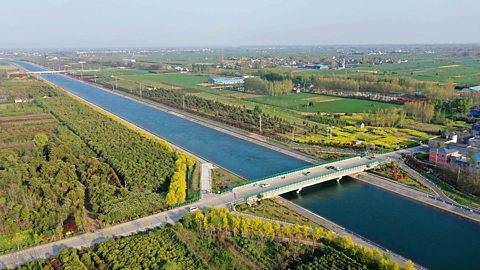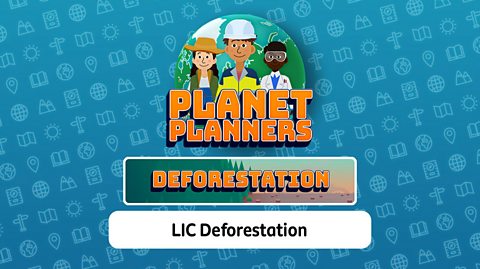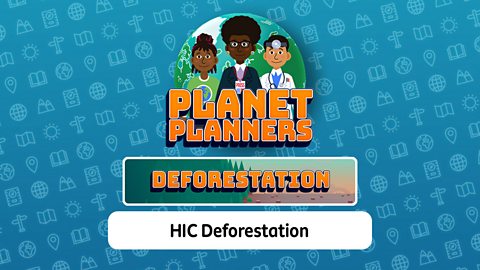What do you know?
In geography, what is a resource?
A resource is any natural material that people need and value.
Key points
- The land contains resources such as minerals, it can also be used for building and leisure.
- Using the land as a resource can have benefits, such as bringing in money, but can also bring challenges such as destruction to the environment.
- The land can be managed in a number of ways such as by protecting it using the National Parks scheme.
The land as a resource
The landThe surface of the earth and all its resources. contains valuable resources such as wood, oil and stone and is itself a very valuable resource.
It provides food to eat, water to drink, the materials needed to make things and the fuel needed for electricity and heat. In addition to this it provides us with space to build and space for leisure.
These natural resources can provide opportunities to countries who have them, but they aren’t evenly distributed throughout the world. This leads countries to trade resources with each other, which can bring money into a country.

How resources are distributed
Game - LIC deforestation
Play a Planet Planners mission to deal with the issues that rainforests face in a low-income country.
You can also play the full game
Challenges of land as a resource
Making use of natural resources can cause serious environmental damage. For example:
- Mining minerals often involves quarryingThe process of removing rock, sand, gravel or other minerals from the ground., which causes the landscapeThe visible areas of land. to be destroyed.
- forestryManaging forests to collect the wood as a resource., building homes and clearing land for agricultureUsing the land to produce food, by growing crops or raising livestock (animals). leads to large scale deforestationThe clearing of forested land for example for building on. in some parts of the world. Deforestation can lead to the loss of habitatAn environment where a particular species of animal or plant lives. for animals and even extinctionThe dying out or extermination of a species because of environmental forces eg overexploitation..
- Burning fossil fuelsNon-renewable natural material that is used as fuel formed over millions of years from the remains of living organisms, eg oil, coal and natural gas. causes pollution and can lead to climate changeThe long-term change of temperature and typical weather patterns. as greenhouse gases are put into the atmosphere, increasing the temperature of the Earth.
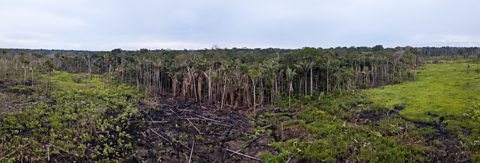
Natural resources are in greater demand than ever and the supply of some of them is running low. The global population is increasing, meaning more resources are consumed. As the world develops and the average standard of livingThe amount of wealth or personal comfort that a person or group of people have. increases around the world, there is also more demand for resources. This means that resources are being used up much faster than they can be replenished. Oil, for example, takes millions of years to form and will run out at some stage in the future.
Competition for resources can also lead to conflictSerious disagreements between individuals or groups. as countries fight over control of these limited resources. There have been a number of wars in which the control of oil supplies has played a big role, for example the Iraq WarMilitary conflict in Iraq that began in 2003 with an attack by a coalition of forces led by the United States. and the conflict in the Darfur region of Sudan. Disputes over waterholes between nomadicAnything that involves moving from place to place eg nomadic hunter-gatherer tribes follow the animals they hunt, carrying their belongings with them. cattle herders and settled farmers have also been a source of conflict.
Question
What are some of the causes of deforestation?
Some of the causes of deforestation include farming, logging, building, mining.
How humans use the land
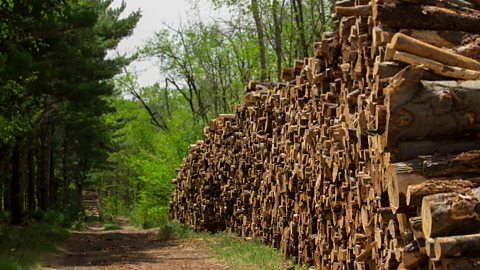
Image caption, Forestry
The land can be deforested to provide either space to farm and build, or for timber and wood.
Image caption, Agriculture
The land provides food to eat, from small scale farms to large scale agricultural businesses.
Image caption, Residential
About 5% of the land in the UK is taken up by houses and gardens.
Image caption, Leisure
Many people take advantage of the ‘right to roam’ and use the UK’s landscape for leisure activities such as walking.
Image caption, Quarrying
Many natural resources lie underneath the ground, such as limestone, which can be collected through quarrying.
1 of 5
Game - HIC deforestation
Play a Planet Planners mission to balance the wealth and care for the environment in a high-income country.
You can also play the full game
Managing the land
Collecting and using resources can cause environmental damage, and some resources are running out. Natural resources, therefore, must be managed in a sustainable way. This means in a way that is good for people and the environment both now and in the future. This can be done in a number of ways.
Countries can protect the land from damage through conservation. This usually means having laws in place which stop, or limit, the use of the land for mining, building, deforestationThe clearing of forested land for example for building on. or other harmful activities. By protecting the land, animals are also saved from extinctionThe dying out or extermination of a species because of environmental forces eg overexploitation..
Rewilding
Conservation usually means maintaining the environment as it is, but it could also mean restoring habitatAn environment where a particular species of animal or plant lives. or even enhancing ecosystems to protect or improve biodiversity. One such method is known as rewilding. Rewilding aims to restore ecosystems to their natural state. This can sometimes involve reintroducing long-disappeared species to some areas, which can have positive and negative impacts on the local people and wildlife.
Faith, a student from Tyneside, looks at the pros and cons of rewilding, and investigates plans to reintroduce the lynx into parts of Kielder Forest for the first time in 1,300 years
Faith: My name’s Faith and I live in the North East. I probably would say that I love the North East only because of the countryside. I read lots of local reports about this new project that wants to reintroduce the lynx cat back in to the wild in Kielder Forest.
Faith: I don’t know much about lynxes, all I know is that they are a wild cat.
Male: The last lynx in Britain was killed for its fur 1300 years ago.
Faith: I thought it would be bigger but it’s not. I thought it would be the size of like a big tiger. But it looks a bit like a cub. And Kielder isn’t far away from where I live so I loved to see lynxes running outside of my house and that would be pretty cool. However, some people say that it’s a bad idea and I want to find out why.
Faith: Rewilding. Is rewilding a good idea?
Faith: Great. Paul from the Lynx Trust is happy to talk to me. But first I want to write down some questions. The Lynx Trust has asked the government if it can conduct a trial to reintroduce the lynx into Northumberland. I want to know why.
Faith: Oh, Paul’s ringing.
Faith: Hi Paul.
Paul O’Donoghue: Hi.
Faith: Dr Paul O’Donoghue is in charge of the project at the Lynx Trust.
Faith: Why do they need to be released?
Paul O’Donoghue: Lynx should be here. They belong here as much as a hedgehog or a badger. Our forests are less healthy without them.
Faith: Letting the lynx be released would it increase any tourism?
Paul O’Donoghue: Lynx are real drivers of tourism. So in Germany where they’ve been reintroduced they generate about £12M a year for tourism which is a massive amount. Imagine that money coming into Kielder Forest.
Faith: How are farmers so against lynxes when they haven’t been around for about 1,300 years?
Paul O’Donoghue: The scientific information says that a lynx kills a sheep about once in every two and a half years. But if a lynx does happen to kill a sheep then we’ll give him all his money back.
Faith: Thanks Paul.
Paul O’Donoghue: You’re very welcome. Bye, bye,
Faith: Bye.
Faith: At this point my mind is definitely for. There’s no reason for anybody to be scared of them and he’s given me a lot of facts. And even a bit of evidence and science definitely helps win me over on that one.
Faith: I’m on my way to Kielder because I need to hear both sides of the story before I make up my mind.
Faith: Kielder Forest is just a 60 mile drive from my school in Gateshead. The lynx Trust wants to release six lynx into this 250 square mile forest because Kielder is big, has few roads and a lot of deer, the lynx’ favourite food.
Faith: Brilliant, a local farmer. Just the person I want to talk to.
Faith: This is huge. There is plenty of room for lynxes. This is amazing.
Faith: I want to find out why Dennis is so against the lynx project.
Faith: Hi Dennis.
Dennis Salt: Hello. And welcome to Rattenraw Farm.
Faith: Thank you.
Faith: What is your view straight up about the lynxes?
Dennis Salt: The straight up view about the lynx I don’t actually think that they should be reintroduced. The Lynx Trust have openly admitted the lynx will definitely predate on sheep and lambs.
Faith: If a sheep was killed by a lynx would the compensation help you or is it just there’s no point?
Dennis Salt: I don’t want sheep killing in the first place. So compensation isn’t a priority.
Faith: Do you see any good points about the tourism side?
Dennis Salt: I think it would actually be a minimal amount of tourism because the lynx are very elusive. Nobody would know where they are apart from the people who are actually tracking them.
Faith: I wonder if the farmer next door agrees with Dennis.
Hi my name’s Faith. So are you for it or against it?
Gerald Todd: Definitely, 100% against it. It will affect our income and our way of life. It’s the final nail in the coffin really. So it’s just a non-starter as far as I’m concerned.
Faith: I’d actually like to take a picture of you guys. I didn’t think it would be like this. I thought I would just make my decision there and then after interviewing both sides. But it’s really difficult. I don’t know how I can choose. I think I need to do a little bit more research before I do definitely make my mind up.
Faith: I’m interested to know if it’s really only farmers in the local area who think this way. I really want to hear some more opinions. Are you interested in animals and nature?
Michelle Grant: Yeah, love it. That’s why I’m here.
Faith: Would you like to see lynxes running wild?
Michelle Grant: Yeah, I’d love it. I think it sounds like a great idea as long as it obviously doesn’t upset the local ecosystem. You know, like it’s not running around tearing up our deer, and that’s a bit of a worry.
Michael Ryan: Certainly all the farmers are against it. But I don’t farm. I’m not a land owner and so I’m fairly neutral.
Michael Brown: It is the most remote village in England and we rely on tourism. And reintroducing the lynxes will bring people into Kielder and it’s better for business and the local community.
Faith: It’s really difficult because the people in the restaurants said they were really looking forward to seeing the lynxes. However, farmer Dennis said you won’t actually be able to see them anyways.
Faith: So, I’ve spoken to people on both sides of the rewilding argument. All their views are convincing but I think I’m ready to make up my own mind.
Faith: At first I was all for the lynxes. I thought they were really cute, loving animals but then speaking to farmer Dennis definitely changed my mind. Because it’s not right. He does this for a living and if the sheep are taken away from him he’s got no living. And it’s exactly the same for the farmers over there, over there and over there.
Faith: I am against this. I don’t want this to go ahead. I don’t think it’s very practical. There’s no need to bring an animal in that was here 1300 years ago.
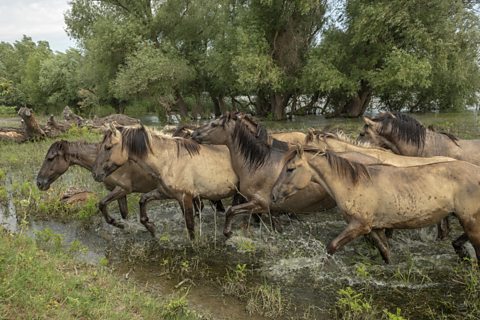
There are a number of ways of carrying out conservation.
National parks
In the UK there are areas designated as national parks. A national park is an area of the country that has been designated for conservation and is protected by the government. In the United Kingdom, there are 15 national parks where building is restricted. These are:
- The Brecon Beacons, The Pembrokeshire Coast, and Snowdonia in Wales,
- The Broads, Dartmoor, Exmoor, The Lake District, New Forest, Northumberland, The North York Moors, The Peak District, The South Downs and The Yorkshire Dales in England.
- The Cairngorms and Loch Lomond & The Trossachs in Scotland.
Areas of Outstanding Natural Beauty (AONBs)
Other areas are given the title of Areas of Outstanding Natural Beauty (AONBs).
An AONB is land protected by the Countryside and Rights of Way Act 2000. This law protects the land in order to conserve and enhance its natural beauty. There are 46 AONBs in England, Wales and Northern Ireland.
The largest of these is the Cotswolds, which covers 787 square miles and the smallest is the Isles of Scilly, at only 6.2 square miles.
Nature reserves
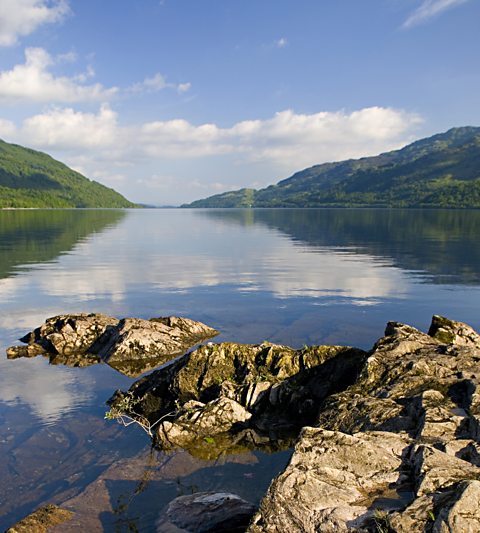
There are more than 380 National Nature Reserves (NNRs) in the UK. These were established to protect some of the UK’s most important habitats, species and geologyRelating to the study of rocks and their location beneath the surface of the Earth., and to provide ‘outdoor laboratories’ for research.
NNRs are very varied environments and include the high mountain summits of Snowdon in Wales; Loch Lomond in Scotland; the sand dunes at Ainsdale in Merseyside and the kettle-hole lakesA round hole formed by retreating glaciers and now filled with water. of Boorin Nature Reserve in Northern Ireland.

Protected areas
Some areas of the countryside have special status as protected areas because of their natural and cultural importance. Protection means that these are covered by laws to make sure that the nature and wildlife are not harmed or destroyed. There are restrictions on activities and development that take place within a protected area such as building new houses or roads.
Conservation can sometimes cause conflict. For a country to develop it needs to use resources. Ending the use of these resources may hold back a country’s development. Conservation, therefore, is a balancing act between protecting the economyAssociated with money. A country or city’s economy refers to the amount of money that the country or city can make. and protecting the environment.
Question
How many National Nature Reserves (NNRs) are there in the UK?
There are more than 380 National Nature Reserves (NNRs) in the UK.
Test your knowledge
Play the Planet Planners game! gamePlay the Planet Planners game!
Make decisions for the planet in this KS3 geography game.

More on Environment, resources and conflict
Find out more by working through a topic
- count2 of 9

- count3 of 9

- count4 of 9
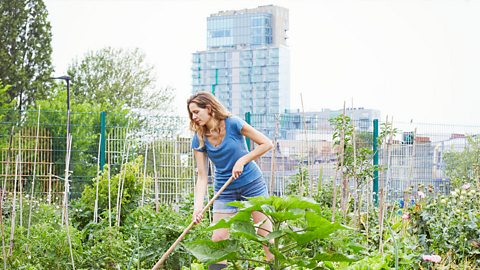
- count5 of 9
